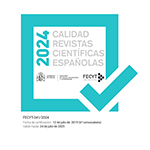La luna e i falò: between prose and poetry
Abstract
After the Thirties, trends in Italian narrative are towards delyricization. Cesare Pavese follows this trend, but, as he isn’t fond of middle tones, he doesn’t come to a ‘degree zero’ writing. This is clear from the way Pavese deals with regional e dialectal lexicon in La luna e i falò (assimilating dialectal elements to general or literary terms, he brings nourishment to the word). In this essay, Beccaria points out that, beyond lexicon, Pavese’s stylistic research reveals itself also in the difficult selection of rhythmic and intonative figures, in control over punctuation, in syntactic essentialness: choices that produce a text oscillating between prose and metrical forms, a prose tending to poetry.Downloads
Article download
License
In order to support the global exchange of knowledge, the journal Cuadernos de Filología Italiana is allowing unrestricted access to its content as from its publication in this electronic edition, and as such it is an open-access journal. The originals published in this journal are the property of the Complutense University of Madrid and any reproduction thereof in full or in part must cite the source. All content is distributed under a Creative Commons Attribution 4.0 use and distribution licence (CC BY 4.0). This circumstance must be expressly stated in these terms where necessary. You can view the summary and the complete legal text of the licence.










